
|
|

June 19, 2009
"....Now Concludes its Broadcast Day"
 It
took a little longer than originally planned, and it hit some
bumps along the way, but the long road to the end of full-power
analog television in the United States came to its conclusion
a week ago today, bringing to a close more than 68 years of the
NTSC broadcast standard.
It
took a little longer than originally planned, and it hit some
bumps along the way, but the long road to the end of full-power
analog television in the United States came to its conclusion
a week ago today, bringing to a close more than 68 years of the
NTSC broadcast standard.
In last week's installment of Tower Site of the Week, we stuck close to home as we watched the stations of Rochester and Buffalo go dark. But as we were sleeplessly shuttling up and down the Thruway to catch all the local action, TV geeks (and we mean that lovingly) all over the country were busy documenting the transition in their markets, too - and thanks to the miracle of YouTube, there are dozens of analog signoffs preserved for posterity. So this week, we'll highlight a few of the better ones...and more of the NERW-land signoffs for which photos have been provided, too.
Down the Thruway in Albany, for instance, WXXA-TV (Channel 23) chief engineer Sarge Cathrall was up at Pinnacle Mountain at 11:59 PM to shut down the analog side of the Fox affiliate he put on the air 27 years ago, just as his colleagues around the market were pulling the plugs on their analog signals.
(You can see the video of all the stations going dark at once here, and we've got a comprehensive tour of Sarge's analog and digital installations on an earlier Site of the Week installment, here.)
Three hours to the east, our colleague Garrett Wollman was in place at the Newton, Massachusetts transmitter site of WHDH-TV (Channel 7) to catch Boston's second-oldest TV station as it left the analog airwaves forever.
That's engineer Brian Edgerton turning off the old Larcan analog transmitter, moments after silencing sister station WLVI (Channel 56) by remote control and moments before moving WHDH-DT from channel 42 to channel 7. And as you'll read when you check out all of Garrett's pictures from the night, channel 42 didn't stay dark long, being reactivated just a few days later after problems cropped up with reception of the VHF digital signal.
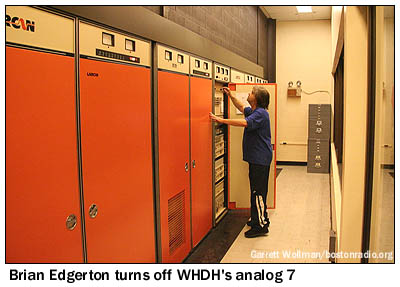 |
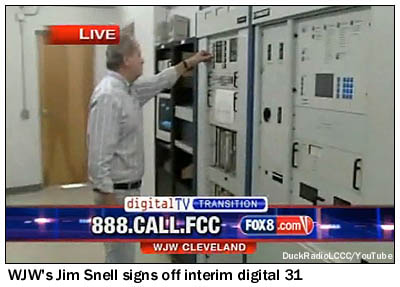 |
It wasn't just WHDH having problems with VHF digital. Thanks to a YouTube poster we're pretty sure is actually our pal Nathan Obral (a regular reader, like us, of the Ohio Media Watch and Ohio Digital TV sites), we have video of Cleveland Fox affiliate WJW-TV, moments after silencing analog channel 8 and digital channel 31, turning on its new digital channel 8 transmitter...and launching a flood of complaints from viewers having trouble seeing that signal.
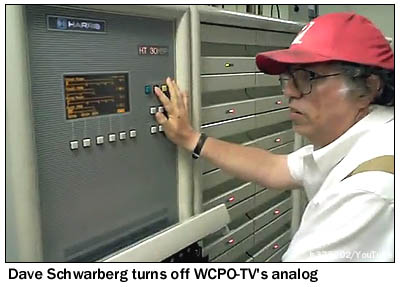 |
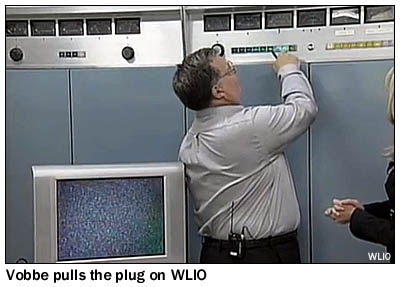 |
At the other end of I-71, Cincinnati ABC affiliate WCPO-TV (Channel 9) is also experiencing some issues with its VHF signal on channel 10 - and here we see its engineer, Dave Schwarberg, turning off the analog channel 9 signal, live on the air.
One more from the Buckeye State, and it's a significant one indeed: Fred Vobbe, chief engineer at Lima's WLIO-TV (Channel 35), is a longtime friend of the column, and he was live on the air at the end of the morning news on Friday to shut down the venerable RCA analog transmitter there. (Channel 35 won't stay dark forever in Lima; it will eventually reappear as the digital home of one of the many LPTVs that are now part of the Lima Broadcasting family, which now encompasses not only NBC affiliate WLIO but also ABC, CBS, Fox and CW outlets.)
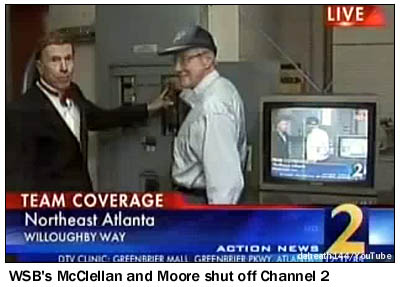 |
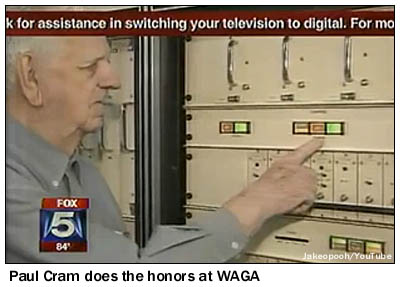 |
Down in Atlanta, it was all about history as some of the South's oldest stations left the analog airwaves at noontime. WSB-TV (Channel 2) was the first station in the market, and it brought back veteran reporter Don Moore and former news director Ray Moore to flip the breaker that killed the analog signal. Over at WAGA-TV (Channel 5), 99-year-old retired engineer Paul Cram, who turned the station on way back in 1949, came back to turn it off. (We recently visited WAGA, and we'll have some pictures of this site in more detail in an upcoming Site of the Week.)
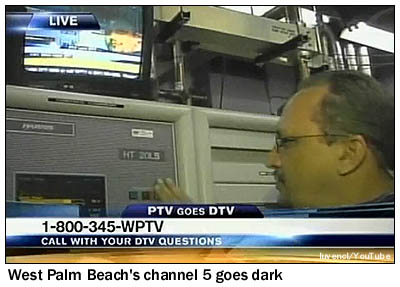 |
 |
Down in Florida, a frequent E-skip visitor to our area, West Palm Beach's WPTV (Channel 5) signed off live on the air at 5:45 AM, and while its engineer was all alone at the transmitter site for that event, they were having a party later that night at Chicago indie WCIU (Channel 26), which broke away from its regular programming on the analog transmitter at 11:45 PM for a live broadcast from the Sears Tower transmitter room. That's director of engineering Kyle Walker pushing the button amidst the festivities - and just days earlier, he gave us a tour of this room, which you'll also see in an upcoming Tower Site of the Week.
(WCIU's doing something neat with its remaining analog LPTV signals: WWME-LP, channel 23, is now carrying the WCIU programming most of the day, but it's also simulcasting morning and early-evening newscasts from NBC's WMAQ and the 9 PM news from WGN-TV for the benefit of remaining analog-only households.)
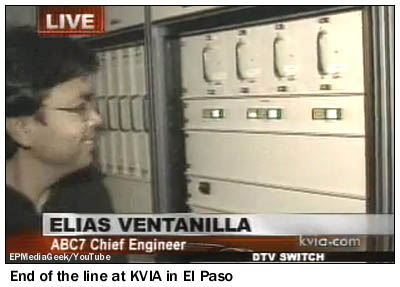 |
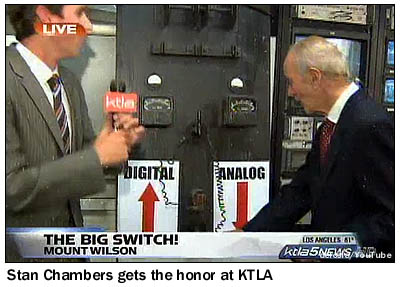 |
Working our way west, we stop off in El Paso to see KVIA-TV (Channel 7) chief engineer Elias Ventanilla shut down the analog signal there - and we wrap up this week at one of the nation's oldest TV outlets, KTLA (Channel 5) in Los Angeles, where the 10:45 PM end of analog operation was handled - at least for show - by the station's beloved Stan Chambers, whose history with television in Los Angeles goes almost back to KTLA's beginnings in the 1940s.
That knife switch he's throwing - with his grandson Jamie looking on - was purely ceremonial, and it took a few seconds after that for the channel 5 analog signal to really disappear from the airwaves. "Slowest electrons ever," as another YouTube poster quipped - but it was still fitting to have the man who did so much to get TV started in Los Angeles on hand as an era ended.
(And don't miss the amazing compilation videos two other Angeleno YouTube posters put together, showing most of the market's stations ending their analog operations.)
Got photos of your local stations pushing the button? More videos? Send them along, and we'll run them in an upcoming Tower Site of the Week...
- Previous Site of the Week: Analog TV - The End
- Next Week: Erie, Pennsylvania TV
- Site of the Week INDEX!
- How can you help support Site of the Week? Click here!
- Submit your suggestions for a future Site of the Week!
